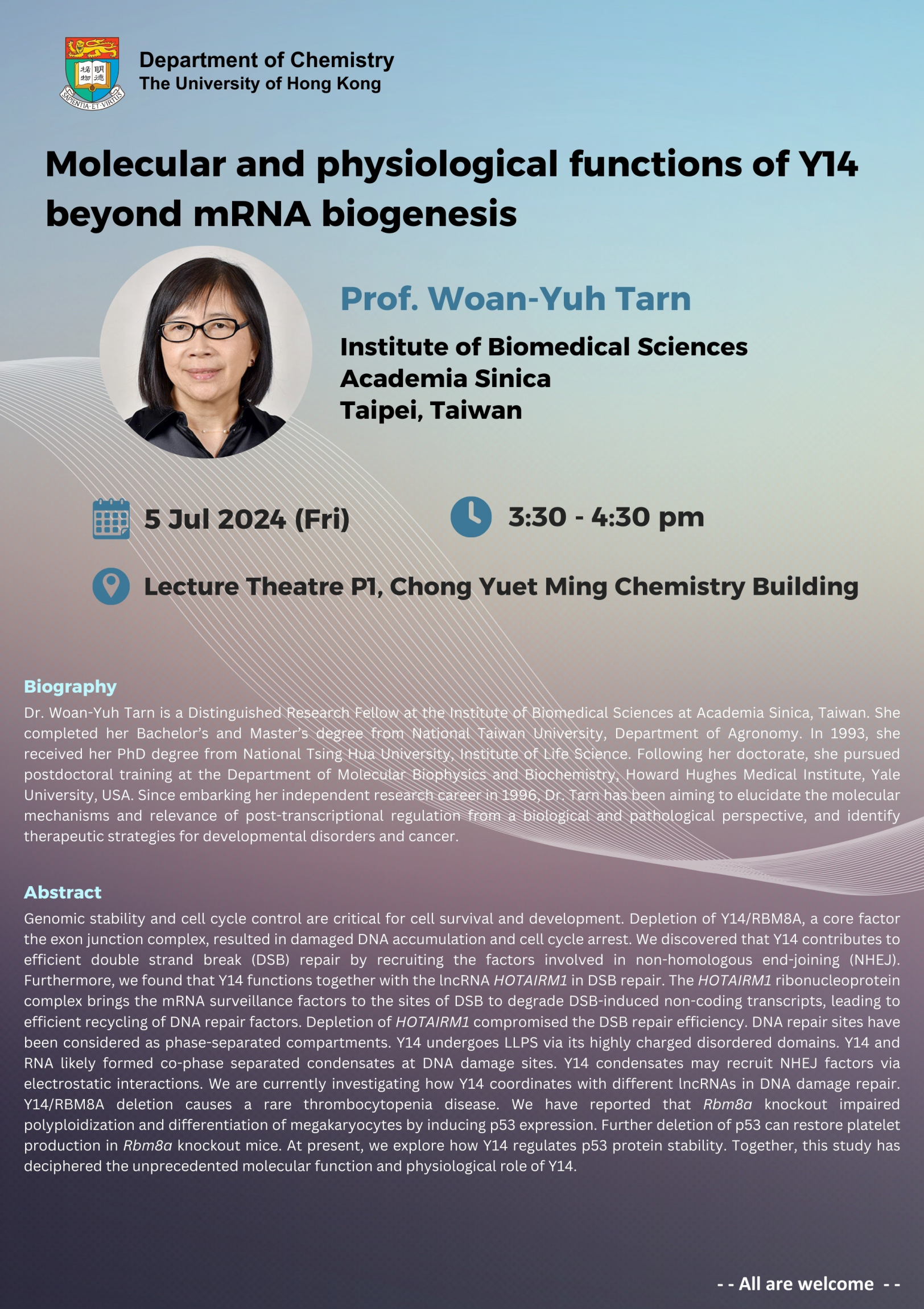| Date | 05 Jul 2024 |
| Time | 3:30 pm - 4:30 pm (HKT) |
| Venue | Lecture Theatre P1, Chong Yuet Ming Chemistry Building |
| Speaker | Prof. Woan-Yuh Tarn |
| Institution | Institute of Biomedical Sciences Academia Sinica Taipei, Taiwan |

Title:
Molecular and physiological functions of Y14 beyond mRNA biogenesis
Schedule:
Date: 5th July, 2024 (Friday)
Time: 3:30 - 4:30 pm (HKT)
Venue: Lecture Theatre P1, Chong Yuet Ming Chemistry Building
Speaker:
Biography:
Dr. Woan-Yuh Tarn is a Distinguished Research Fellow at the Institute of Biomedical Sciences at Academia Sinica, Taiwan. She completed her Bachelor’s and Master’s degree from National Taiwan University, Department of Agronomy. In 1993, she received her PhD degree from National Tsing Hua University, Institute of Life Science. Following her doctorate, she pursued postdoctoral training at the Department of Molecular Biophysics and Biochemistry, Howard Hughes Medical Institute, Yale University, USA. Since embarking her independent research career in 1996, Dr. Tarn has been aiming to elucidate the molecular mechanisms and relevance of post-transcriptional regulation from a biological and pathological perspective, and identify therapeutic strategies for developmental disorders and cancer.
Abstract:
Genomic stability and cell cycle control are critical for cell survival and development. Depletion of Y14/RBM8A, a core factor the exon junction complex, resulted in damaged DNA accumulation and cell cycle arrest. We discovered that Y14 contributes to efficient double strand break (DSB) repair by recruiting the factors involved in non-homologous end-joining (NHEJ). Furthermore, we found that Y14 functions together with the lncRNA HOTAIRM1 in DSB repair. The HOTAIRM1 ribonucleoprotein complex brings the mRNA surveillance factors to the sites of DSB to degrade DSB-induced non-coding transcripts, leading to efficient recycling of DNA repair factors. Depletion of HOTAIRM1 compromised the DSB repair efficiency. DNA repair sites have been considered as phase-separated compartments. Y14 undergoes LLPS via its highly charged disordered domains. Y14 and RNA likely formed co-phase separated condensates at DNA damage sites. Y14 condensates may recruit NHEJ factors via electrostatic interactions. We are currently investigating how Y14 coordinates with different lncRNAs in DNA damage repair. Y14/RBM8A deletion causes a rare thrombocytopenia disease. We have reported that Rbm8a knockout impaired polyploidization and differentiation of megakaryocytes by inducing p53 expression. Further deletion of p53 can restore platelet production in Rbm8a knockout mice. At present, we explore how Y14 regulates p53 protein stability. Together, this study has deciphered the unprecedented molecular function and physiological role of Y14.
- ALL ARE WELCOME -
